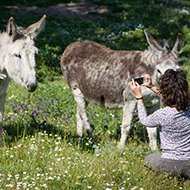New research gives fresh hope to threatened bird
The ring ouzel population has declined by 35 per cent since 1999.
Recent insights could aid the survival of an upland bird species
A long-running project by scientists at RSPB Scotland has recently revealed an insight into the cause of population decline in the ring ouzel, commonly known as the mountain blackbird.
It is hoped that this new evidence will result in actions being taken be taken to halt the decline of this rare upland bird.
The ring ouzel, identified by black plumage and a striking white breastband, lives in the rocky hillsides and gullies of the highest parts of the country, and winters in the mountains of North Africa.
The Scottish population, which makes up two-thirds of the UK population, has declined by 35 per cent since 1999, prompting research into their conservation.
Research undertaken at Glen Clunie in Aberdeenshire suggests that a drop in the survival of young birds in their first year, possibly influenced by a lack of suitable habitat, is likely to have caused the population decline.
Ring ouzels are known to forage for invertebrates and a mix of grass and heather early in the summer, before switching their diet to blackberries and rowan berries later in the year. They also require access to deeper vegetation such as heather, to hide their nests and protect their young from predators.
It is hoped that by creating suitable habitats at the ring ouzel's breeding grounds could help to attract the birds, and provide safe nest sites and abundant foraging, whilst allowing the birds to conceal their young from predators.
Innes Sim is a scientist for RSPB Scotland, and has been studying the ring ouzel since 1998. He said: “Through our long term studies in Glen Clunie we have identified that improving first-year survival may be the key to stabilising, and eventually reversing, the population decline.
“Over the next three years, we will be attempting to improve conditions for ring ouzels, by providing the mix of habitats that we have identified as being important for successful breeding and the survival of recently fledged young.”
Image © Andreas Trepte, www.photo-natur.de







 RCVS Knowledge has called on vet practices to audit their post-operative neutering outcomes.
RCVS Knowledge has called on vet practices to audit their post-operative neutering outcomes.
